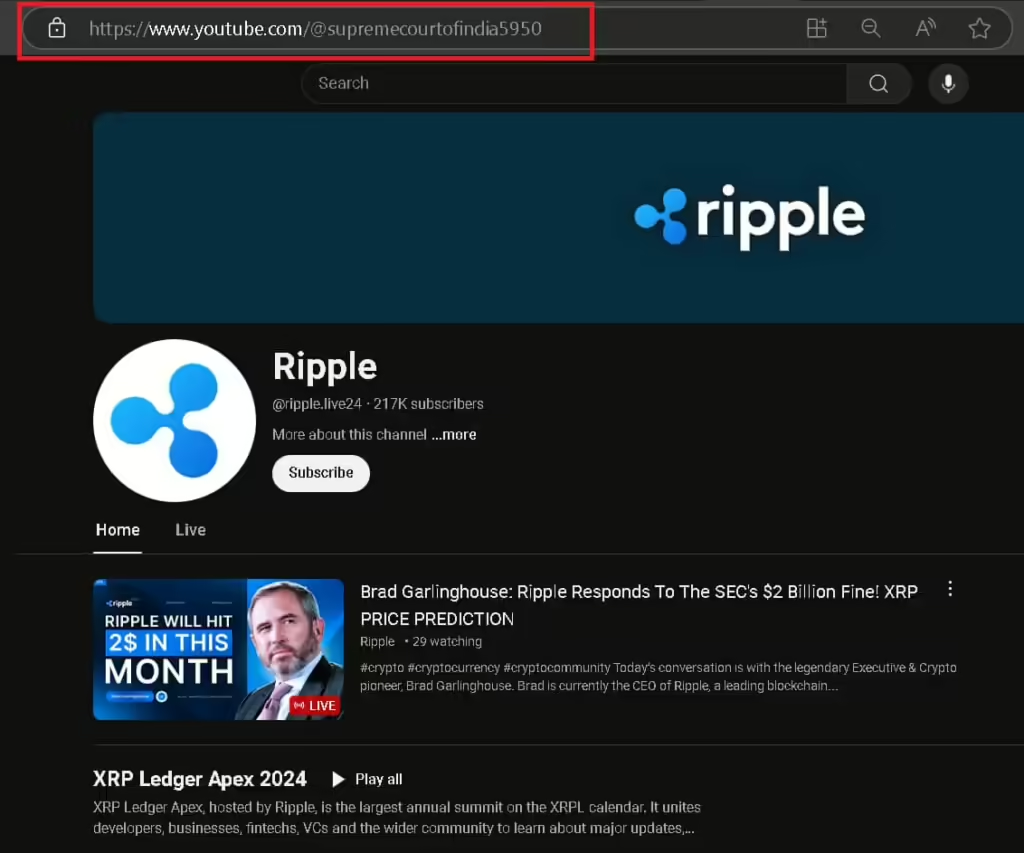
In a worrying incident that underscores the continued vulnerability of online platforms to hacking, the official YouTube channel of the Supreme Court of India was recently hacked by cryptocurrency scammers. The hackers took control of the prominent channel to promote a fraudulent investment scheme involving the digital asset XRP, formerly known as Ripple. Not only did the brazen attack undermine the court’s digital presence, it also highlighted the ongoing threat of cryptocurrency-related scams targeting uninformed victims, similar to the infamous Elon Musk scam and other cryptocurrency scams on YouTube.
Anatomy of Piracy: Rebranding and Impersonation
On September 20, the Supreme Court of India’s YouTube channel, which has over 217,000 followers, was hacked in a sophisticated attack. The perpetrators quickly renamed the channel to resemble Ripple, the company behind the XRP cryptocurrency, and proceeded to delete all previously uploaded content. The strategic move was designed to lend an air of legitimacy to the impending scam, much like the Elon Musk impersonation tactics used in other cryptocurrency-related Ponzi schemes.
Read more: BlackRock’s Bitcoin ETF Gets SEC Approval for Nasdaq Listing
Fake Live Streaming and Fraudulent Promises
The hackers then used the compromised channel to broadcast a live stream featuring Ripple CEO Brad Garlinghouse. The live stream, similar to the fake Elon Musk videos used to expose other scams, purported to offer lucrative investment opportunities in XRP, making unrealistic promises of huge returns. The goal was to lure uninformed viewers into a Ponzi scheme, where they would be encouraged to connect their cryptocurrency wallets to Bitcoin, Ethereum, or Dogecoin and eventually lose their money to fraudulent domains and fake trading bots promising guaranteed daily gains.


Quick Response and Removal from YouTube
Recognizing the seriousness of the situation, YouTube was quick to address the breach. On the same day the channel was hacked, the streaming platform locked the compromised account, denying the scammers further access and preventing them from spreading their fraudulent content. This highlights the importance of automated reporting tools and verified accounts in combating scam sites and pump-and-dump schemes on the platform.
Supreme Court Public Notice and Recovery Efforts
Meanwhile, the Supreme Court of India issued a public notice informing the public of the incident and subsequently removing the channel. This proactive move demonstrated the court’s commitment to transparency and its desire to protect the public from potential financial harm, much like the warnings issued regarding the Michael Sailor scam, the Tesla crypto scam, and the Berkshire Hathaway scam.
Partial channel restoration
In a later update, the Indian Supreme Court announced that her YouTube account had been successfully recovered from the XRP hackers. However, further investigation revealed that the channel’s original subscriber base of over 217,000 followers and previous video uploads could not be fully recovered. The recovered account was renamed “Vansh” and had only 15 million followers. Subscriberswhich is a significant difference from its state before the hack, highlighting the lasting damage caused by social media hacks.
Read more: Can Supra Oracle Achieve 500K TPS? Check Technical Specifications
Ongoing challenges and implications
The inability to fully restore the Supreme Court’s YouTube channel highlights the ongoing challenges online platforms face in the wake of such breaches. The loss of the channel’s subscriber base and content archive underscores the long-term impact of these attacks, which can extend beyond the initial incident, similar to the fallout from Elon Musk’s bitcoin hoax and other celebrity impersonation schemes.
A Wider Trend of Cryptocurrency Scams on YouTube
The Supreme Court’s YouTube channel hijacking is not an isolated incident. In fact, it’s part of a broader trend of cryptocurrency scams on the video-sharing platform. During Apple’s iPhone 16 launch in September, YouTube was flooded with fake videos and sponsored videos featuring fraudster Tim Cook peddling cryptocurrency scams to unsuspecting viewers, much like Mr Beast’s cryptocurrency code and Elon Musk’s AI scam.
YouTube’s Efforts to Mitigate Cryptocurrency Scams
YouTube’s support team has acknowledged the prevalence of these scams and has taken steps to address the issue. In a September 9 post on X (formerly Twitter), the platform urged users to report any suspicious crypto-related content through its official reporting tool. This collaborative approach between the platform and its user community is crucial in combating the ongoing threat of financial fraud on YouTube, including scams such as the Biticodes scam, Moneytoken scam, Lymenex scam, Beast task scam, Moontenx scam, Uwerx scam, Bitreels scam, and Bayex.io scam.
conclusion
The Supreme Court of India’s experience with the YouTube hijacking serves as a cautionary tale for organizations and individuals working in the digital space. As crypto adoption and associated scams continue to rise, the need for robust cybersecurity measures such as hardware wallets, OCR detection, Google Vision API, data visualization monitoring, and wallet blacklisting, along with increased public awareness about the exploitation of cognitive bias, has never been more urgent.
Disclaimer: The information contained in this article is for informational purposes only and does not constitute financial advice. Investing in cryptocurrencies involves risks, and readers should conduct their own research and consult with their financial advisors before making investment decisions. Hash Herald is not responsible for any profits or losses in this process.


Comments are closed, but trackbacks and pingbacks are open.